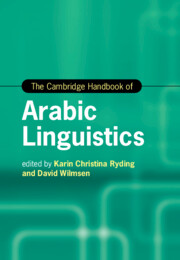Book contents
- The Cambridge Handbook of Arabic Linguistics
- Cambridge Handbooks in Language and Linguistics
- The Cambridge Handbook of Arabic Linguistics
- Copyright page
- Contents
- Figures
- Tables
- Notes on Contributors
- Acknowledgements
- Abbreviations
- Introduction
- Part I Arabic Applied Linguistics
- Part II Arabic Variation and Sociolinguistics
- Part III Theoretical and Descriptive Studies
- Part IV Arabic Computational and Corpus Linguistics
- Part V Arabic Linguistics and New Media Studies
- Part VI Arabic Linguistics in Literature and Translation
- 23 Vernacular Varieties in Recent Arabic Literature
- 24 Stylistics and Translation
- Index
- References
24 - Stylistics and Translation
A Corpus-Based Case Study of English–Arabic Demonstratives
from Part VI - Arabic Linguistics in Literature and Translation
Published online by Cambridge University Press: 23 September 2021
- The Cambridge Handbook of Arabic Linguistics
- Cambridge Handbooks in Language and Linguistics
- The Cambridge Handbook of Arabic Linguistics
- Copyright page
- Contents
- Figures
- Tables
- Notes on Contributors
- Acknowledgements
- Abbreviations
- Introduction
- Part I Arabic Applied Linguistics
- Part II Arabic Variation and Sociolinguistics
- Part III Theoretical and Descriptive Studies
- Part IV Arabic Computational and Corpus Linguistics
- Part V Arabic Linguistics and New Media Studies
- Part VI Arabic Linguistics in Literature and Translation
- 23 Vernacular Varieties in Recent Arabic Literature
- 24 Stylistics and Translation
- Index
- References
Summary
Mai Zaki demonstrates an applied linguistic approach to corpus analysis in a relatively new direction in translation studies which uses parallel corpora for the evaluation of translated texts. The chapter treats specifically the representation of deixis in texts translated from English to Arabic, demonstrating that beyond a simple transfer of lexis between languages, expressing deixis must convey speaker (or writer) worldview, conceptions of distance from the deictic centre and any semantic, syntactic, or even cultural constraints operating on expressions of spatial, temporal, and intra-textual reference. Translators most often (about half the time) tend to maintain thematic attention to the entity referred to in the physical environment and in the preceding text. However, in a significant number of instances (about 20 per cent each in the sample), they either shift the deixis to the opposite end of the distance spectrum (ذلك / تلك ‘that’ instead of هذا / هذه ‘this’) or they insert a demonstrative into the target text where none is present in the source text. Translators’ maintenance of the same deictic projections as those of the authors is a common strategy, but it is not the only one.
Keywords
- Type
- Chapter
- Information
- The Cambridge Handbook of Arabic Linguistics , pp. 583 - 611Publisher: Cambridge University PressPrint publication year: 2021



